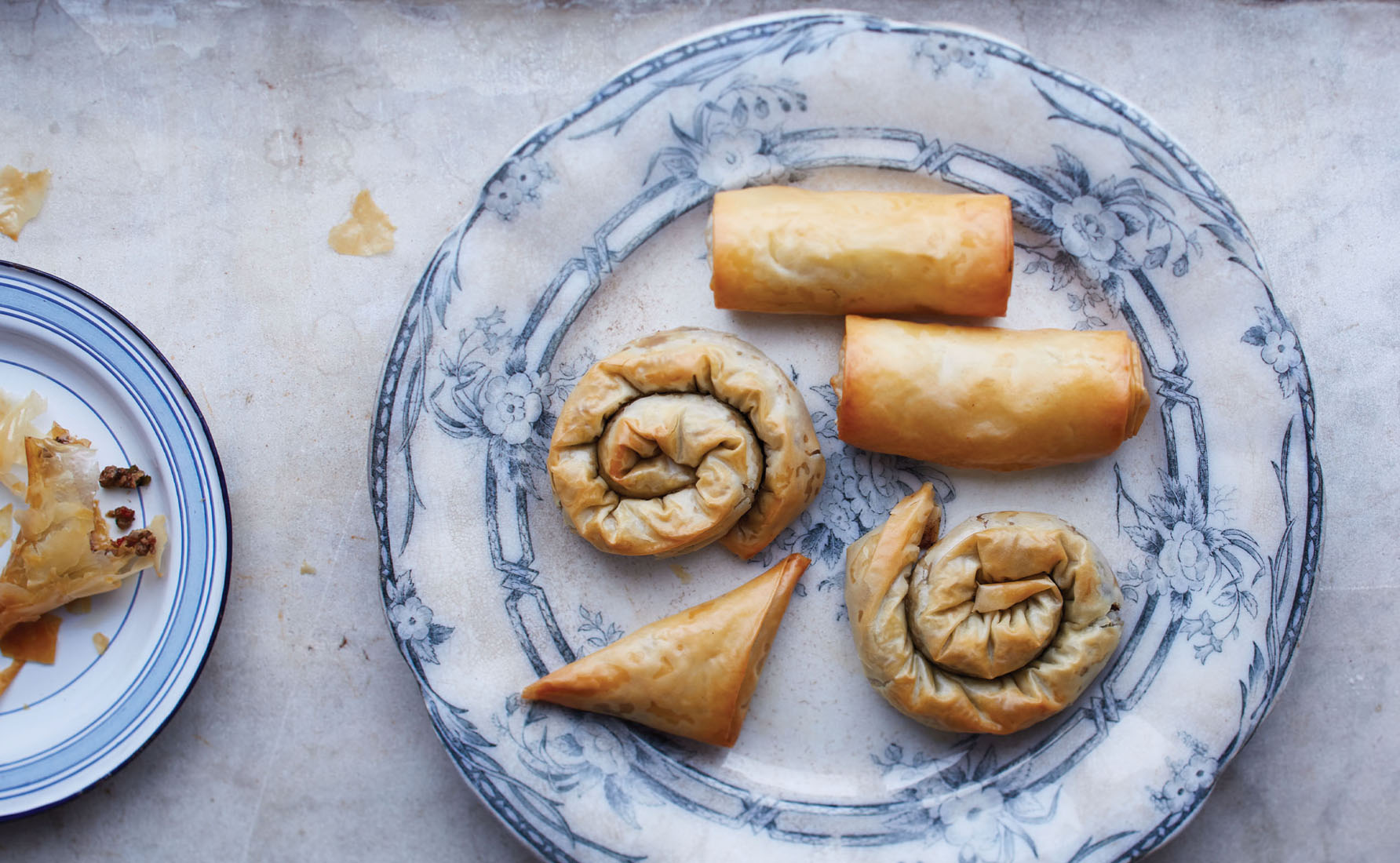BAKLAVA YUFKASIYLA KIYMALI MUSKA BÖREGI
TURKEY

Most people know baklava as a sweet nut-filled pastry dripping with sugar syrup. However, baklava can also describe savory pastries such as the boreks below, which can be made in different shapes as in the photo above. Before World War I, elegant households in Istanbul kept two phyllo makers, one to make the thinner sheets for sweet baklava and the other to make sturdier sheets for boreks. Sadly, this custom has died and it is rare nowadays for phyllo to be made at home. As for the origin of phyllo dough, it is undoubtedly of Turkish origin despite the Greeks’ claim to it.
MAKES 8 INDIVIDUAL BOREKS
FOR THE FILLING
1½ tablespoons extra-virgin olive oil
½ teaspoon cumin seeds
1 large onion (7 ounces/200 g), finely chopped
2 tablespoons pine nuts
1 clove garlic, minced to a fine paste
½ cup finely diced red bell pepper
Scant 1 tablespoon finely chopped fresh chili pepper
½ pound (225 g) lamb shoulder, trimmed of fat and minced
Half of a 14-ounce (400 g) can whole peeled tomatoes, finely chopped
1½ tablespoons golden raisins
A few sprigs flat-leaf parsley, most of the stems discarded, finely chopped
2 tablespoons finely chopped fresh dill
½ teaspoon ground allspice
Sea salt and finely ground black pepper
FOR THE BOREKS
8 sheets phyllo dough (9 x 14 inches/22.5 x 35 cm)
5½ tablespoons (80 g) unsalted butter, melted
1. To make the filling: Heat the oil in a large skillet over medium-high heat. Add the cumin seeds and stir until fragrant. Add the onion and pine nuts and cook, stirring regularly, until lightly golden. Stir in the garlic.
2. Add the peppers and lamb and stir, breaking up any lumps, until the meat is no longer pink. Add the tomatoes, golden raisins, herbs, and allspice. Season with salt and pepper to taste. Cook, stirring occasionally, for a few minutes until there is no longer any liquid in the pan. Let cool.
3. Preheat the oven to 400°F (200°C).
4. To make the boreks: Lay one phyllo sheet on your work surface. Keep the others covered with plastic wrap and a kitchen towel so that they don’t dry out. Brush the sheet of phyllo with melted butter. Fold it lengthwise in half. Put one-eighth of the meat filling at the end of the strip nearest to you and fold the pastry over the filling to form a triangle. Brush the strip of phyllo with butter and continue folding, keeping the triangle shape and brushing with butter every two folds or so, until you have encased the filling entirely and made a neat triangle—trim any excess. Brush with butter on both sides and transfer to a nonstick baking sheet (or a regular baking sheet lined with parchment paper or a silicone baking mat), seam side down. Repeat to make 8 triangles total.
5. Bake for 20 to 25 minutes, or until golden all over. Serve hot or warm.
COILED BOREKS: For coiled boreks, fold a sheet of phyllo in half lengthwise and brush with butter. Spread one-eighth of the filling in a line over the length of the folded pastry, leaving about ½ inch (1 cm) clear at the edges. Roll the phyllo over the filling and continue rolling until you have encased the filling in a long log, then coil the log into a spiral (see photo). Brush with butter on both sides and bake as directed.
FAT FINGERS: To make fat fingers, fold a sheet of phyllo in half lengthwise and brush with butter. Spread one-eighth of the filling across the end nearest to you, leaving ½ inch (1 cm) free at the sides. Fold the sides over the filling and all the way down the strip of phyllo, then roll the phyllo up over the filling and continue rolling until you have completely encased the filling. Brush with butter all over and bake as directed.